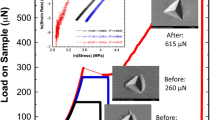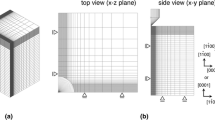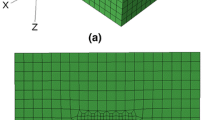Abstract
Single crystal KCl and MgO indentation hardness test results spanning macroscopic, microstructural, and nanoscale measurements are brought together in a ball-indenter-based stress–strain description. For a significant range of hardness measurements made on MgO (001) crystal surfaces, increasingly greater plastic flow stresses are determined at smaller loads applied to smaller effective ball sizes at the rounded tips of Berkovich indenters; and, at the smallest ball diameters of 3,200 nm and 400 nm, the plastic flow stresses are shown to approach the predicted Hertzian elastic loading stresses. The resultant hardness stress–strain description, that is extended to cover the elastic, plastic, and cracking behaviors of MgO crystals, is usefully applied also to a comparison of indentation test results reported for NaCl and RDX crystals. In general, the dislocation-induced cracking stress measurements are shown for MgO and RDX crystals to be lower than cracking stresses evaluated on an (elastic) indentation fracture mechanics (IFM) basis. Comparison is made with metal nanoindentation hardness test results.






Similar content being viewed by others
References
Tabor D (1951) The hardness of metals. Clarendon, Oxford, U.K
Bunshah RF, Armstrong RW (1973) Continuous ball indentation test for examining hardness dependence on indenter size, ball size, and material grain size. In: Westbrook JH, Conrad H (eds) The science of hardness testing and its research applications. American Society for Metals, Metals Park, OH, pp 318–328 Ch. 26
Armstrong RW, Robinson WH (1974) Combined elastic and plastic deformation behavior from a continuous indentation hardness test. NZ J Sci 17:429–433
Cousins WJ, Armstrong RW, Robinson WH (1975) Young’s modulus of lignan from a continuous indentation test. J Mater Sci 10:1655–1658. doi:10.1007/BF00554925
Robinson WH, Truman SD (1977) Stress–strain curve for aluminum from a continuous indentation test. J Mater Sci 12:1961–1965. doi:10.1007/BF00561967
Oliver WC, Pharr GM (1992) An improved technique for determining hardness and elastic modulus using load and displacement sensing indentation experiments. J Mater Res 7:1564–1583. doi:10.1557/JMR.1992.1564
Ferranti L Jr, Armstrong RW, Thadhani NN (2004) Elastic/plastic deformation behavior in a continuous ball indentation test. Mater Sci Eng A 371:251–255. doi:10.1016/j.msea.2003.12.003
Feng C, Kang BS-J (2006) A transparent indenter measurement method for mechanical property evaluation. Exp Mech 46:91–103. doi:10.1007/s11340-006-5862-5
Feng C, Kang, BS-J (2007) Young’s modulus measurement using a simplified transparent indenter measurement technique. Exp Mech doi: 10.1007/s11340-007-9074-4
Armstrong RW, Ferranti L Jr, Thadhani NN (2006) Elastic/plastic/cracking indentation behavior of hard materials. Int J Refract Met Hard Mater 24:11–16. doi:10.1016/j.ijrmhm.2005.03.004
Lu C, Ma Y-W, Tam PL, Shen YG (2007) Nanoindentation-induced elastic-plastic transition and size effect in α-Al2O3(0001). Philos Mag Lett 87:409–415. doi:10.1080/09500830701203156
Chaudhri MM (1998) Enhanced cathodoluminescence from nano-indentations in MgO. Philos Mag Lett 77:7–16. doi:10.1080/095008398178714
Chaudhri MM (2004) Dislocations and indentations. In: Nabarro FRN, Hirth JP (eds) Dislocations in solids. Elsevier B.V, Oxford, UK, pp 447–550 Vol. 12, Ch. 70
Gaillard Y, Tromas C, Woirgard J (2006) Quantitative analysis of dislocation pile-ups nucleated during nanoindentation in MgO. Acta Mater 54:1409–1417. doi:10.1016/j.actamat.2005.11.013
Tromas C, Girard JC, Audurier V, Woirgard J (1999) Study of the low stress plasticity in single-crystal MgO by nanoindentation and atomic force microscopy. J Mater Sci 34:5337–5342. doi:10.1023/A:1004705206482
Coupeau C, Girard J-C, Rabier J (2004) Scanning probe microscopy and dislocations. In: Nabarro FRN, Hirth JP (eds) Dislocations in solids. Elsevier B.V, Oxford, UK, pp 273–338 Vol. 12, Ch. 67
Hammond BL, Armstrong RW (1988) Recovered elastic and plastic strains at residual micro-indentations in an MgO crystal. Philos Mag Lett 57:41–47. doi:10.1080/09500838808227796
Armstrong RW, Raghuram AC (1973) Anisotropy of microhardness in crystals. In: Westbrook JH, Conrad H (eds) The science of hardness testing and its research applications. American Society for Metals, Metals Park, OH, pp 174–186 Ch. 13
Armstrong RW, CCm Wu (1978) Lattice misorientation and displaced volume for microhardness indentations in MgO crystals. J Am Ceram Soc 61:102–106. doi:10.1111/j.1151-2916.1978.tb09248.x
Armstrong RW, Elban WL (1986) Dislocation aspects of plastic flow and cracking at indentations in magnesium oxide and cyclotrimethylenetrinitramine explosive crystals. In: Blau PJ, Lawn BR (eds) Microindentation techniques in materials science and engineering. American Society for Test and Materials, Philadelphia, PA, pp 109–126 ASTM STP 889
Gaillard Y, Tromas C, Woirgard J (2003) Study of the dislocation structure involved in a nanoindentation test by atomic force microscopy and controlled chemical etching. Acta Mater 51:1059–1065. doi:10.1016/S1359-6454(02)00509-8
Woirgard J, Tromas C, Audurier V, Girard JC (1998) Nanoindentation study of very low stress plasticity. In: Fundamentals of nanoindentation and nanotribology. Mater Res Soc 522:65–70. Warrendale, PA
Lawn BR (1968) Hertzian fracture in single crystals with the diamond structure. J Appl Physi 39:4828–4836. doi:10.1063/1.1655847
Armstrong RW, Elban WL (2004) Dislocations in energetic crystals. In: Nabarro FRN, Hirth JP (eds) Dislocations in solids. Elsevier B.V, Oxford, UK, pp 403–446 Vol. 12, Ch. 69
Armstrong RW (2005) Dislocation pile-ups: From {110} cracking in MgO to model strength evaluations. Mater Sci Eng A 409:24–31. doi:10.1016/j.msea.2005.04.060
Armstrong RW, Elban WL (2006) Materials science and technology aspects of energetic (explosive) materials. Mater Sci Tech 22:381–395. doi:10.1179/174328406X84049
Poon B, Rittel D, Ravichandran G (2008) An analysis of nanoindentation in linearly elastic solids. Int J Solids Struct 45:6018–6033. doi:10.1016/j.ijsolstr.2008.07.021
Bahr DF, Jennerjohn SL, Morris DJ (2009) Dislocation nucleation and multiplication in small volumes: The onset of plasticity during indentation testing. J Met 61(2):56–60
Armstrong RW, Elban WL (1989) Cracking at hardness micro-indentations in RDX explosive and MgO single crystals. Mater Sci Eng A 111:35–43. doi:10.1016/0921-5093(89)90195-0
Armstrong RW, Shin H, Ruff AW (1995) Elastic/plastic effects during very low-load hardness testing of copper. Acta Metall Mater 43:1037–1043. doi:10.1016/0956-7151(94)00291-O
Lim YY, Chaudhri MM (1999) The effect of the indenter load on the nanohardness of ductile metals; an experimental study on polycrystalline work-hardened and annealed oxygen-free copper. Phil Mag A 79:2979–3000. doi:10.1080/01418619908212037
Shim S, Bei H, George EP, Pharr GM (2008) A different type of indentation size effect. Scripta Mater 59:1095–1098. doi:10.1016/j.scriptamat.2008.07.026
Pathak S, Shaffer J, Kalidindi SR (2008) Determination of an effective zero-point and extraction of indentation stress–strain curves without the continuous stiffness measurement signal. Scr Mater. doi:10.1016/j.scriptamat.2008.11.028
Zhu TT, Bushby AJ, Dunstan DJ (2008) Size effect in the initiation of plasticity for ceramics in nanoindentation. J Mech Phys Solids 56:1170–1185. doi:10.1016/j.jmps.2007.10.003
Ohmura T, Tsuzaki K (2007) Plasticity initiation and subsequent deformation behavior in the vicinity of single grain boundary investigated through nanoindentation technique. J Mater Sci 42:1728–1732. doi:10.1007/s10853-006-0885-y
Eliash T, Kazakevich M, Semenov VN, Rabkin E (2008) Nanohardness of molybdenum in the vicinity of grain boundaries and triple junctions. Acta Mater 56:5640–5652. doi:10.1016/j.actamat.2008.07.036
Acknowledgments
One of the co-authors, Ron Armstrong, thanks Dr. Yves Gaillard for providing both helpful reprints and information concerning his comprehensive measurements made with colleagues on nanoindenting MgO (001) crystal surfaces. Helpful correspondence has been with Dr. Munawar Chaudhri, also, in connection with Fig. 2 and with the related references [30, 31]. Publication of the present article has been supported by the UM Department of Mechanical Engineering, Center for Energetic Concepts Development (CECD).
*Notes added in proof
1. During the review period, the authors recognized that a fuller interpretation could be applied to the initial nanoindentation test results shown in Figs. 2 and 3: If the initial loading and pop-in displacements are added in each case and employed to determine dp in equation (2), then paired {(d/D), σH} values of {~0.48, ~8.7 GPa} and {~0.33, ~7.0 GPa} are respectively computed. On such basis then, the spherically-tipped nanoindentation test results are seen to follow an analogous trend to that described for the initial macroindentation test results in Fig. 1.
2. An excellent review of the history of indentation hardness testing up to the date of current reference [1] has been provided very recently in the publication: Hutchings IM (2009) The contributions of David Tabor to the science of indentation hardness. J Mater Res 24:581–589.
Author information
Authors and Affiliations
Corresponding author
Rights and permissions
About this article
Cite this article
Armstrong, R.W., Elban, W.L. Macro- to Nano-indentation Hardness Stress–Strain Aspects of Crystal Elastic/Plastic/Cracking Behaviors. Exp Mech 50, 545–552 (2010). https://doi.org/10.1007/s11340-009-9246-5
Received:
Accepted:
Published:
Issue Date:
DOI: https://doi.org/10.1007/s11340-009-9246-5




